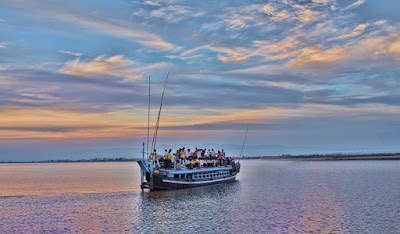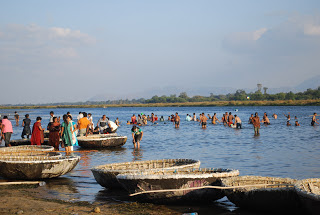Famous as the “World’s largest fresh water island”, this idyllic river island on the River Brahmaputra is located 20 kilometers away from the city of Jorhat. Referred to as the cultural capital of Assam, Majuli is a beautiful and unexplored place resplendent with several festivals throughout the year. A must visit offbeat place t travel.
Ideal season to visit Majuli: Majuli is probably most beautiful during the monsoon, when the river is swollen and beautiful. October-March is a nice time to visit, with the cool climate makes a trip to Majuli absolutely worthwhile.
Mājuli or Majoli is a large river island in the Brahmaputra River, Assam, India. The island had a total area of 1,250 square kilometres (483 sq mi), but having lost significantly to erosion it had an area of only 352 square kilometres (136 sq mi) in 2014. Majuli has shrunk as the river surrounding it has grown.
The island is formed by the Brahmaputra river in the south and the Kherkutia Xuti, an anabranch of the Brahmaputra, joined by the Subansiri River in the north. Mājuli island is accessible by ferries from the city of Jorhat. The island is about 200 kim east from the state's largest city —Guwahati. It was formed due to course changes by the river Brahmaputra and its tributaries, mainly the Lohit. Mājuli is the abode of the Assamese neo-Vaisnavite culture.
Originally, the island was a long, narrow piece of land called Majoli (land in the middle of two parallel rivers) that had the Brahmaputra flowing in the north and the Burhidihing flowing in the south, till they met at Lakhu. Frequent earthquakes in the period 1661–1696 set the stage for a catastrophic flood in 1750 that continued for 15 days, which is mentioned in historical texts and reflected in folklore. As a result of this flood, the Brahmaputra split into two branches — one flowing along the original channel and the other flowing along the Burhidihing channel and the Mājuli island was formed. The Burhidihing's point of confluence moved 190 km east and the southern channel which was the Burhidihing became the Burhi Xuti. The northern channel, which was previously the Brahmaputra, became the Luit Xuti. In due course, the flow in the Luit Xuti decreased, and it came to be known as the Kherkutia Xuti; and the Burhi Xuti expanded via erosion to become the main Brahmaputra River.

The locals speak in the Mising and Assamese languages.
Reference regarding the early existence of Majuli is found in Yogini Trantathat Sutiya king Ratnadhajpal founded his capital in Ratanpur, Majuli which was perhaps washed away by the Brahmaputra.
Mājuli has been the cultural capital of Assamese civilisation since the 16th century; based on written records describing the visit of Srimanta Sankardeva — a 16th-century social reformer. Sankardeva, a pioneer of the medieval-age neo-Vaishnavite movement, preached a monotheist form of Hinduism called Vaishnavism and established monasteries and hermitages known as satra on the islet.
The island soon became the leading center of Vaishavinism with the establishment of these satras. After the arrival of the British, Majuli was under the rule of the British until India gained independence in 1947. It is one of world's biggest river islands.
Economy
The main industry is agriculture, with paddy being the chief crop. Mājuli has a rich and diverse agricultural tradition, with as many as 100 varieties of rice grown, all without pesticides or artificial fertilisers. Among the fascinating arrays of rice produced are the Komal Saul, a unique type that can be eaten after immersing the grains in warm water for 15 minutes and usually eaten as a breakfast cereal; the bao dhan, that grows under water and is harvested after ten months; and the Bora saul, a sticky brown rice used to make the traditional cake known as pitha. Fishing, dairying,pottery, handloom and boat-making are other important economic activities.
Handloom is a major occupation among the distaff population of the villages. Although largely a non-commercial occupation, it keeps many of the inhabitants occupied. Weaving is exquisite and intricate with the use of a variety of colours and textures of cotton and silk, especially Muga silk.

The island has been the hub of Assamese neo-Vaishnavite culture, initiated around 15th century by the revered Assamese saint Srimanta Sankardeva and his disciple Madhavdeva. Many Satras or monasteries constructed by the saint still survive and represent the colourful Assamese culture. The saint took refuge in Mājuli and spent a couple of months at Beloguri in West Mājuli, which was a place of grandeur for the historic and auspicious, 'Manikanchan Sanjog' between Shankardeva and Madhavdeva, this was the first satra in Mājuli. After the "Manikanchan Sanjog", sixty five satras were set up. However, today only twenty-two of the original sixty-five are operational. Sixty-five out of the six hundred and sixty-five original satras in Assam were situated in Mājuli.
The main surviving Satras (Satra) are:
- Dakhinpat Satra: Founded by Banamalidev, a supporter of Raasleela, which is now observed as one of the National Festivals of Assam.
- Garamurh Satra: This "Satra" was founded by Lakshmikantadeva. During the end of autumn, the traditional the Raasleela is enacted with pomp and celebrations. Ancient weapons called "Bartop" or cannons are preserved here.
- Auniati Satra: Founded by Niranjan Pathakdeva, the satra is famous for the "Paalnaam" and Apsara Dances and also its extensive assortment of ancient Assamese artefacts, utensils, jewellery and handicrafts. It also has a hundred and twenty five disciples and over seven hundred thousand followers worldwide.
- Kamalabari Satra: The Kamalabari Satra, founded by Bedulapadma Ata, is a centre of art, cultural, literature and classical studies on the island. Its branch the Uttar Kamalabari Satra has performed cultural programmes of the Satria Art all around the country and abroad.
- Benegenaati Satra: It is a reliquary of antiques of cultural importance and an advance centre of performing art. Muraridev, the grandson of Sankaradeva's stepmother was the founder of the Satra. The royal raiment belongs to the Ahom king Swargadeo Godadhar Singha, is made of gold. Also preserved is the royal umbrella made in gold.
- Shamaguri Satra: The satra is famous for the mask making in India.
These satras are the treasure house of "Borgeet" Matiakhara, Satriya Dances (Jumora Dance, Chali Dance, Notua Dance, Nande Vringee, Sutradhar, Ozapali, Apsara Dance, Satria Krishna Dance and Dasavater Dance), all promulgated by Srimanta Sankardeva. It has become a center for shuddhi in the Northeast of India, due to the efforts of Pitambar Deva Goswami.
Mājuli is 20 km from Jorhat. One can take the bus or a hired taxi to the Nimati Steamer Ghat from where ferry services ply. The distance takes over three hours to cover, with three bus rides and two ferry rides.
On the north bank is the river Subansiri and on the south bank, the mighty Brahmaputrahas excided the island from the main land. Lakhimpur town is to the north and Golaghat is to its southwest. The town of Sibsagar is on the southeast and Jorhat is to the south. On the extreme east is Dibrugarh District.
- The Vaishnava Satras founded by Sankardeva
- The colourful culture of the tribes
- Migratory birds
- The Ali-ai-ligang festival in Feb-March
- Pottery making
- Mask making





































